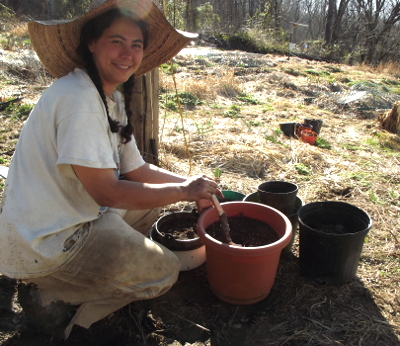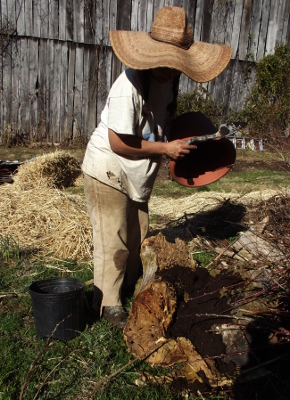
Reusing potting soil
 Those of you who love plants
have probably jumped over a similar hurdle. Maybe you tried to
overwinter a tomato plant and it eventually gave up the ghost, or you
have a house plant that was potted up into a larger containetr, leaving some
soil behind. Either way, you're left with dirt from which the
nutrients are mostly gone, but with plenty of yummy organic matter left.
Those of you who love plants
have probably jumped over a similar hurdle. Maybe you tried to
overwinter a tomato plant and it eventually gave up the ghost, or you
have a house plant that was potted up into a larger containetr, leaving some
soil behind. Either way, you're left with dirt from which the
nutrients are mostly gone, but with plenty of yummy organic matter left.
The best use of old
potting soil depends in part on your house plant style, and on what
kind of mixture you started with. In the most typical scenario,
you bought potting soil from the big box store and you use chemical
fertilizers to feed your plants. In this case, you might as well
reuse the potting soil since you're basically growing your plant
hydroponically, using the potting soil as a structural element
only. You might want to mix the old potting soil half and half
with high quality compost or new potting soil, though, to add a few
nutrients to the earth.
(As a side note, if your
plant died from something soil related, you won't want to reuse the
troubled dirt as is. Some gardeners report good results with
sterilizing the soil by pouring boiling water over it, or by baking the
soil in the oven. Finally, you could simply add the potting soil
to the outdoors garden, where beneficial microorganisms will make short
work of the bad guys.)
 At the other extreme, you
might make your potting soil out of a mixture of compost, stump
dirt, or other
organic materials like I do. In this case, your potting soil is
providing the nutrients as well as the structural components, which is
why you'll need to topdress your potted plants at least once a year and
to cut away part of the roots of long-lived plants to replace some soil lower
down.
At the other extreme, you
might make your potting soil out of a mixture of compost, stump
dirt, or other
organic materials like I do. In this case, your potting soil is
providing the nutrients as well as the structural components, which is
why you'll need to topdress your potted plants at least once a year and
to cut away part of the roots of long-lived plants to replace some soil lower
down.
In this homegrown
scenario, depleted potting soil should head out to the garden, where it
will act as a soil amendment. I dumped mine between logs in a hugelkultur bed, but you could also
apply the old potting soil to the top of a bed in the vegetable garden
or alongside a tree mound that needs to be expanded. The soil is
probably low in nitrogen, but is unlikely to be low enough that it will
grab nitrogen out of nearby earth. Instead, it will help fluff up
your garden soil, increase its water retention capacity, and make
microorganisms happy.
(By the way, thanks for
cleaning up the office, honey!)
Want more in-depth information? Browse through our books.
Or explore more posts by date or by subject.
About us: Anna Hess and Mark Hamilton spent over a decade living self-sufficiently in the mountains of Virginia before moving north to start over from scratch in the foothills of Ohio. They've experimented with permaculture, no-till gardening, trailersteading, home-based microbusinesses and much more, writing about their adventures in both blogs and books.
Want to be notified when new comments are posted on this page? Click on the RSS button after you add a comment to subscribe to the comment feed, or simply check the box beside "email replies to me" while writing your comment.

Ikwig --- Gotta keep your eye out for stumps!
When I topdress my house plants, I just lay new compost on top of the old soil. Later, when I water, nutrients wash down out of the new compost and into the root zone (and the plant starts sending roots up into the compost too.)
My long-lived plants seem to sink down into the pot over time, so topdressing just raises them back up to pot level. If the crown is too low, I'll take the whole thing out and put the new compost underneath the plant instead of on top.
Worm tea is another good choice if you can't wrap your head around urine.